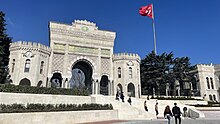
Education in Turkey is governed by a national system which was established in accordance with Atatürk's Reforms. It is a state-supervised system designed to produce a skillful professional class for the social and economic institutes of the country.
Compulsory education lasts 12 years. Primary and secondary education is financed by the state and free of charge in public schools, between the ages of 6 and 19. Turkey has over 200 universities as of 2022. ÖSYS, after which high school graduates are assigned to university according to their performance.
Turkey has 97% of primary school enrollment among all eligible children as of 2019. This number has significantly dropped with the Syrian refugee crisis. Many Syrian children left school during the crisis.
In 2002, the total expenditure on education in Turkey amounted to $13.4 billion, including the state budget allocated through the National Ministry of Education and private and international funds. The share of national wealth invested in educational institutions is higher in Turkey than average among OECD countries. Scientific and Technological Research Council of Turkey is the main national body of R&D in Turkey.
The Human Rights Measurement Initiative (HRMI) finds that when taking into consideration Turkey's income level, the nation is achieving 61.7% of what should be possible based on its resources (income) for primary education and 86.1% for secondary education.
History
See also: Education in the Ottoman Empire See also: Turkish language § Language reform and modern Turkish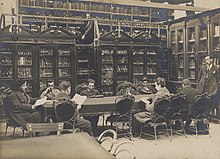



After the foundation of the Turkish Republic the organization of the Ministry of Education gradually developed and was reorganized with the Law no 2287 issued in 1933. The Ministry changed its names several times. It fell under the Ministry of Culture (1935–1941) and was named Ministry of National Education, Youth, and Sports (1983–1989). Since then it has been called the Ministry of National Education. Before the Republic, education institutions were far from having a national character. Schools were organized in three separate channels which were vertical institutions independent of each other. The first and the most common in this organization were the district schools and madrasas based on the teaching of the Quran the Arabian language and memorizing, the second were the Reform schools and high schools supporting innovation and the third were the colleges and minority schools with foreign language education.
The Law of Integration of Education, no 430 was issued on 3 March 1924. With this law, the three separate channels were combined, the first one was closed, the second was developed and the third one was taken under the inspection and monitoring of the Ministry of Education. One of its aims was to apply secularism in the area of education. By the law for the Education Organization no 789 issued on 22 March 1926 the Ministry of National Education was given responsibility for defining the degrees and equalities of the public and private schools already opened or to be opened by a ministry other than the Ministry of National Education. This Law brought new arrangements such as "no school can be opened in Turkey without the permission and agreement of the Ministry of National Education" or "curricula shall be prepared by the Ministry of National Education". The vocational-technical education institutions formerly directed by local governments were put under the responsibility of the Ministry of Education.
In 1923–24, there were in Turkey, slightly more than 7,000 secondary school students, almost 3,000 high school students, some 2,000 technical school students and officially 18,000 medrese students of whom 6,000 are claimed to be actual students and the rest who registered to be excluded from military service. The population of Turkey was at that moment some 13–14 million.
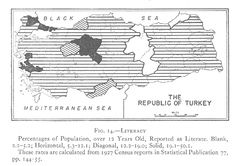
On 1 November 1928, Law no 1353 introducing a new Latin-based alphabet was accepted. In 1931, the Turkish Association of History, and in 1932, the Turkish Language Association were established to protect Turkish from influences of foreign languages, improve it as science suggests and prevent misuse of the Turkish language. The Republican Turkish authorities initially had twelve education districts headed by people appointed by the ministry, but later gave more power to local authorities, with education directors appointed by provincial authorities.
- there were 5,100 schools in 1923, this figure increased to 58,800 in 2001
- there were 361,500 students in 1923, this number increased to 16 million in 2001
- in 1923 12,200 teachers were employed, this number increased to 578,800 in 2001.
- in 1924 there were 479 medrese (Islamic schools); on average each one of them had approximately 1 or 1.5 hoca (teacher). All medrese were closed down that year by the law of Tevhid-i Tedrisat.
In 1938 mobile courses for women were organized in order to support the further education of the rural female population. Youths who finished primary school as well women to the age of 45 were admitted to take part in these courses. A course lastet for 8 months and then the teachers travelled on to a next village. Between 1940 and 1974 almost 305,000 women took part in 13,429 courses. About 240,000 graduated from the courses with success.
Until 1997 children in Turkey were obliged to take five years of education. The 1997 reforms introduced compulsory education for eight years. New legislation introduced in March 2012 prolonged compulsory education to 12 years (İlköğretim ve Eğitim Kanunu ile Bazı Kanunlarda Değişiklik Yapılmasına Dair Kanun).
In July 2017, the Justice and Development Party (AKP) government presented a new curriculum for schools, inter alia removing evolution theory and adding the concept of jihad as part of Islamic law in books.
Pre-primary education
Pre-primary education includes the optional education of children between 36 and 72 months who are under the age of compulsory primary education. Pre-primary education institutions, independent nurseries, are opened as nursery classes and practical classes within formal and non-formal education institutions with suitable physical capacity. Services related to pre-primary education are given by nurseries, kindergartens, practical classes opened first and foremost by the Ministry of National Education and by day-centers, nursery schools, day care houses, child care houses and child care institutions opened by various ministries and institutions for care or education purposes based on the provisions of ten laws, two statutes and ten regulations. In the academic year 2001–2002, 256,400 children were being educated and 14,500 teachers were employed in 10,500 pre-primary education institutions.
Primary education

Primary school (Turkish: İlköğretim Okulu) lasts 8 years. Primary education covers the education and teaching directed to children between 6–14, is compulsory for all citizens, boys or girls, and is given free of charge in public schools. Primary education institutions are schools that provide eight years of uninterrupted education, at the end of which graduates receive a primary education diploma. The first four years of primary school is sometimes referred to as "First School, 1st Level" (Turkish: İlkokul 1. Kademe) but both are correct.
There are four core subjects at first, second and third grades which are Turkish, mathematics, Hayat Bilgisi (literally meaning "life knowledge"), and foreign language. At fourth grade, Hayat Bilgisi is replaced by science and social studies. The foreign language taught at schools changes from school to school. The most common one is English, while some schools teach German, French or Spanish instead of English. Some private schools teach two foreign languages at the same time.
Earlier the term "middle school" (Turkish: ortaokul) was used for the three years education to follow the then compulsory five years at "First School" (Turkish: ilkokul). Now the second four years of primary education are sometimes referred to as "First School, 2nd Level" (Turkish: İlkokul 2. Kademe) but both are correct. Primary schools may be public or private. Public schools are free but private schools' admission fees change from school to school. Foreign languages taught at private schools are usually at a higher level than at public schools since most private schools prefer hiring native speakers as teachers.
There are five core subjects at sixth and seventh grades: Turkish, mathematics, science, social studies, and foreign language. At eighth grade, social studies is replaced by "Turkish History of Revolution and Kemalism" (Turkish: T.C. İnkılap Tarihi ve Atatürkçülük).
In the academic year 2001–2002, 10.3 million students were being educated and 375,500 teachers were employed in 34,900 schools.
Secondary education
See also: List of high schools in Turkey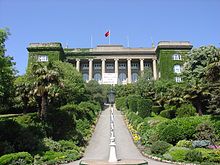

Secondary education includes all of the general, vocational and technical education institutions that provide at least three years of education after primary school. The system for being accepted to a high school changes almost every year. Sometimes private schools have different exams, sometimes there are 3 exams for 3 years, sometimes there's only one exam but it is calculated differently, sometimes they only look at your school grades. Secondary education aims to give students a good level of common knowledge, and to prepare them for higher education, for a vocation, for life and for business in line with their interests, skills and abilities. In the academic year 2001–2002 2.3 million students were being educated and 134,800 teachers were employed in 6,000 education institutions.
General secondary education covers the education of children between 15 and 17 for at least three years after primary education. General secondary education includes high schools, foreign language teaching high schools, Anatolian High Schools, high schools of science, Anatolia teacher training high schools, and Anatolia fine arts high schools.
Vocational and technical secondary education involves the institutions that both raise students as manpower in business and other professional areas, prepare them for higher education and meet the objectives of general secondary education. Vocational and technical secondary education includes technical education schools for boys, technical education schools for girls, trade and tourism schools, religious education schools, multi-program high schools, special education schools, private education schools and health education schools.
Secondary education is often referred as high school education, since the schools are called lyceum (tr: lise).
In public high schools and vocational high schools, students attend six classes each day, which last for approximately 40 minutes each. In Anatolian high schools and private high schools, the daily programme is typically longer, up to eight classes each day, also including a lunch period. All 9th graders are taught the same classes nationwide, with minor differences in certain cases. These classes are: Turkish language, Turkish literature, mathematics, physics, chemistry, biology, geometry, world history, geography, religion & ethics, physical education, a foreign language (in most cases English), a second foreign language (most commonly German but could be French, Italian, Japanese, Arabic, Russian, or Chinese).
When students enter the 11th grade, they typically choose one of four tracks: Turkish language–mathematics, science, social sciences, and foreign languages. In vocational high schools, no tracks are offered, while in science high schools only the science tracks are offered. Different schools may have different policies; some, but not many, schools offer electives instead of academic tracks, giving students a wider range of options. For the 10th, 11th and 12th grade, the compulsory courses are: Turkish language, Turkish literature and republican history. In addition to that, students may be taught the following classes, depending on the track they choose and/or the high school they attend: mathematics, geometry, statistics, physics, biology, chemistry, geography, philosophy, psychology, sociology, economy, logic, arts and music, traffic and health, computer, physical education, first and second foreign language.

The students used to be given a diploma for the academic track they had chosen, which gave them an advantage if they wanted to pursue their higher education in the corresponding fields, as the University Entrance Exam scores were weighted according to the student's track. (e.g. A science student would have an advantage over a Turkish-Mathematics student when applying for Medicine). As of the 2010–2011 educational year, all high school students are given the standard high school diploma.
At the end of high school, following the 12th grade, students take a high school finishing examination and they are required to pass this in order to take the University Entrance Exam and continue their studies at a university. There are four score types for different academic fields, including but not limited to:
- Turkish language–mathematics: international relations, law, education, psychology, economy, business management, and similar.
- Science: engineering, computer science, medicine, and other science-related professions.
- Social sciences: history, geography, and education.
- Foreign languages: language/linguistics and language teaching.
International education

The International Baccalaureate has been available in Turkey since 1994 when the first school was authorized by the IB and 53 schools now offer one or more of the IB programmes.
Vocational education

Vocational and technical secondary education involves the institutions that both raise students as manpower in business and other professional areas, prepare them for higher education and meet the objectives of general secondary education. Vocational and technical secondary education includes technical education schools for boys, technical education schools for girls, trade and tourism schools, religious education schools, multi-program high schools, special education schools, private education schools and health education schools. In the academic year 2001–2002, 821,900 students were being educated and 66,100 teachers were employed in 3,400 vocational and technical secondary education schools.
According to Article 37 of Vocational Education Law no 3308, the Ministry of National Education is organizing vocational courses in order to prepare the people who have left the formal education system and do not possess the qualifications required for employment for any vacant positions in the business sector. Based on apprenticeship training programs, the Ministry of National Education pays the insurance premiums against occupational accidents, sicknesses during the vocational period and other sicknesses of participants attending courses in relation to their occupation. These participants may take experienced apprenticeship exams after the education they have received and the work they have performed are evaluated according to the Regulations for Evaluating the Certificates and Diplomas in Apprenticeship and Vocational Training.
People who work in the 109 branches mentioned in Law no 3308, have finished primary education and are below the age of 14 may receive training as candidate apprentices or apprentices. Law no 4702 gives apprenticeship training opportunity to those over 19. The period of apprentice training changes between 2–4 years depending on the nature of vocations.
Adolescents who have not attended the formal education system or left the system at any stage may take the experienced apprenticeship exam after 1 year of adaptation training, provided they had reached the age of 16 at the date when the said profession was included in the coverage of law. Those at the age of 18 may directly take the experienced apprenticeship exam, if a certificate is provided to prove that he/she is working in the related profession.
Those who graduate from vocational and technical secondary education institutions or from vocational and technical schools and institutions may take proficiency exam in their own professions. Graduates of technical high school or of 4-year programs in vocational and technical schools and institutions are given a certificate to start businesses with the privileges and responsibilities of a proficiency certificate. In 2001, 248,400 apprentices were being educated and 5,100 teachers were employed in 345 vocational training centers.
International students
In recent years, Turkey has become a popular destination for international students. The main reasons are the affordable tuition fees compared to destinations of similar reputation such as Eastern Europe and easier accessibility for international students. Applicants can take the YÖS exam, Turkish university entrance exam for foreign students, or apply with international university admissions such as SAT or high school diploma.
The new system: 4+4+4

In March 2012 the Grand National Assembly passed new legislation on primary and secondary education usually termed as "4+4+4" (4 years primary education, first level, 4 years primary education, second level and 4 years secondary education). Children will begin their primary education in the first month of September following their sixth birthdays and will come to a close during the school year in which students turn 14 years old.
The primary education stages, which includes the first two stages of four years' education each, will entail four years of mandatory elementary education, followed by an additional mandatory four years of middle school education, in which students will be able to choose whether they want to study at a general education middle school or a religious vocational middle school, which are referred to as Imam Hatip schools. The new legislation includes the reopening of Imam Hatip middle schools. Primary education establishments will be set up separately as independent elementary schools and middle schools.
Universities





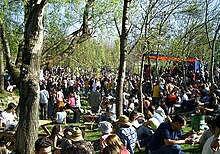
Higher education includes all levels of institutions giving education past the secondary school level for a period of at least 17 years.
Higher education institutions include:
- Universities
- Faculties
- Institutes
- Higher education schools
- Vocational higher education schools
- Conservatories
- Application and research centers
In the 1930s, at the suggestion of Albert Einstein, the Atatürk government hired over a thousand established academics, including world renowned émigré professors escaping the Nazi takeover in Germany. Most were in medicine, mathematics, and natural science, plus a few in the faculties of law and the arts. Germany's exiled professors served as directors in eight of twelve Istanbul's basic science Institutes, as well as six directors of Istanbul's seventeen clinics at the Faculty of Medicine.
In the academic year 2001–2002 there were 76 universities, 53 of which belonged to the state and 23 to foundations. In these institutions 66,700 personnel were working, 63,000 in state universities and 3,700 in others.
After the national university entrance examination organized by the Measuring, Selection and Placement Center students, if they succeed, continue with their studies at a university. Foreign students take the YÖS Examination or provide equivalent credentials approved by the Council of Higher Eduation.
Universities provide either two or four years of education for undergraduate studies, while graduate programs last a minimum of two years. Some universities also ask for an additional year of English preparatory study to be completed before the start of studies, unless an exemption examination is passed.
There are around 820 higher education institutions including universities with a total student enrollment of over 1 million. Tertiary education is the responsibility of the Higher Education Council, and funding is provided by the state for public institutions that make up the bulk of the tertiary education system. There are 167 universities in Turkey, which are classified as either public or foundational (private) and 373,353 students were graduated from these universities in 2006. Public universities typically charge very low fees while private foundation universities are highly expensive with fees that can reach $30,000 per annum. Since 1998, universities have been given greater autonomy and were encouraged to raise funds through partnerships with industry.
The quality of education at Turkish universities varies significantly, with some institutions offering education and facilities comparable to internationally renowned universities. Notably, technical universities in Turkey are often compared to their counterparts in the United States. These universities are regularly evaluated by the Accreditation Board for Engineering and Technology (ABET), and their engineering programs are frequently deemed substantially equivalent to similar programs in the United States.
With the passage of law 2547, the rectors of all the public universities are appointed jointly by the faculty, Higher Education Council and the President of Turkey. The former president, Abdullah Gül, suggested that the system might be changed to eliminate the Higher Education Council and political influence.
Turkey is a member of the Socrates Programme, Erasmus Programme and Erasmus+. Turkey is also a member of the Erasmus Student Network, a student organization with more than 15,000 volunteers across Europe. Turkey has become a hub for foreign students in recent years, with 795,962 foreign students in 2016. The government has announced a plan to draw around 500,000 foreign students at its universities by offering attractive scholarships. In 2021 Türkiye Scholarships, a government-funded program, received 165,000 applications from prospective students in 178 countries.
Research
The Scientific and Technological Research Council of Turkey (TÜBİTAK) coordinates basic and applied research and development, acting on proposed policies by the Turkish Academy of Sciences (TÜBA). There are more than 60 research institutes and organizations. Turkey's R&D strengths include agriculture, forestry, health, biotechnology, nuclear technologies, minerals, materials, IT, and defence.
Private schools
In the Turkish education system, private schools may be grouped into four.
- Private Turkish schools: In these schools, which are opened by real or corporate bodies of Turkish nationality, public education programs at pre-primary, primary and secondary education levels are given.
- Private schools for minorities: These have been established in the Ottoman Empire period by Greek, Armenian and Jewish minorities and were placed under guarantee by the terms of the Lausanne Treaty. These schools are attended by students at pre-primary, primary and secondary education levels who belong to these minority classes and are of the Turkish nationality.
- Private foreign schools: These are schools established during the Ottoman Empire by French, German, Italian, Austrian and American people who continue their activities under the terms of the Lausanne Treaty. Today these schools are attended by Turkish children.
- Private international education institutions: They have been opened and are active as per the provisions in the amended article 5 of the Law no. 625.
There are many dershane in cities. They will transform into academic high schools in 2015, as the new law requires.
Religious education


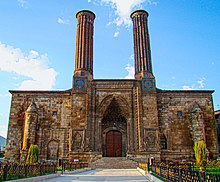

De-establishment
In 1927, all courses concerning religion were excluded from the curriculum of primary, secondary, and high schools on the basis that non-Muslims also live in Turkey. Between 1927 and 1949, religious instruction was not permitted in schools. In 1949, the Ministry of Education allowed a course on religion in 4th and 5th grades of primary school.
Re-establishment
In 1956, as a result of multi-party democracy, a new government was established. Being more sympathetic towards the religious sentiments of society, this new government introduced a religion course into secondary schools. This time, if the parents wanted to exempt their children from the course, they had to apply to the school with a written request. After nearly ten years, in 1967, the religion course was introduced to the 1st and 2nd grades of high school. Students, however, were enrolled for the course with the written request of their parents. In 1975, the course was extended to the third (last) grade of the high schools. And, finally, following the military coup in 1980, the religion course became schools was also constitutionally secured. The exact title of the course was, "The Culture of Religion and Knowledge of Ethics."
In 1985, the Institute for Creation Research, a United States creationist group, helped advise Turkey's education minister Vehbi Dinçerler on how to introduce creationism in high schools. Turkish academics have stated that the resulting ignorance of evolution led to Turkey coming last in a survey that measured knowledge of evolution in 34 industrialised nations.
Currently, religious education courses begin at the 4th grade (age10) of primary school and continues throughout secondary and high schools. From the 4th to the 8th grade, classes consist of two hours per week. At the high school level, there is one hour of class per week Thus, a student who has graduated from high school receives 8 continuous years of religion courses. There are no fixed books for the course. Rather, each school decides which book to follow—provided that the book for each level is approved by the Ministry of Education. Nearly half of the content of these courses concerns religion and Islam (whom majority are Muslims) with remaining topics ranging from secularism to humanism and from ethical values to etiquette. The major world religions such as Judaism, Christianity, Hinduism and Buddhism are included in the content of the course.
Foreign languages
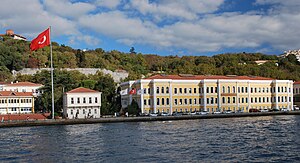
The most common foreign language is English, which in public schools is taught from 2nd grade (age 8) onwards through to the end of high school. In high school a second foreign language is introduced. However the number of lessons given in public schools is minimal compared to private schools, which begin teaching English in kindergarten, have two or three times as many English lessons in the timetable, and in many cases employ native speakers of English as teachers.
In 2011 the Ministry of Education, under pressure from the Prime Minister to improve the learning of English in Turkey, announced that the approach to language would be thoroughly revised, part of which would include a plan to hire 40,000 foreigners as language assistants in public schools. As a result of the poor standards achieved by the public system many students take an intensive English language "prep year" when entering university. These are offered by both state and private universities throughout Turkey.
In 2012, the Ministry of Education included Kurdish (based on both Kurmanji and Zazaki dialects) to the academic programme of the basic schools as optional classes from the fifth year on.
Later, the Ministry of Education also included Abkhaz, Adyghe, Standard Georgian, and Laz languages in 2013, and Albanian as well as Bosnian languages in February 2017.
In 2015, the Ministry of Education announced that as of the 2016–17 academic year, Arabic courses (as a second language) will be offered to students in elementary school starting in second grade. The Arabic courses will be offered as an elective language course like German, French and English. According to a prepared curriculum, second and third graders will start learning Arabic by listening-comprehension and speaking, while introduction to writing will join these skills in fourth grade and after fifth grade students will start learning the language in all its four basic skills.
Indoctrination
Further information: Turkish textbook controversies See also: The Twenty Classes
Turkish education system requires students to be educated on the basis of Turkish nationalism in Atatürk's thought (Atatürk milliyetçiliği) and aims to create individuals who are committed to laique, democratic values of Turkey.During Atatürk's presidency, schools to Turkefy the Kurds such as the Elazig Girls' Institute were set up. In the late 1990s, the National Security Council, which at the time was dominated by a secular military, demanded the administration of the Prime Minister Necmettin Erbakan to carry out regulations aiming to curb rising Islamic fundamentalism.
Every weekday early in the morning student oath was to be sung by students until it was abolished in 2013. In every classroom, a portrait of Atatürk, lyrics of the National Anthem and text of Atatürk's Address to Turkish Youth are hung high up at the wall. In history lessons, nationalistic values are promoted and denialism of Armenian genocide is taught.
Criticism
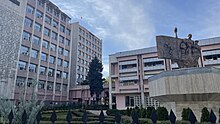
Education
Constant alterations of education system in Turkey has caused controversy. In 2005 preparatory classes for foreign languages were abolished with only a few high school being exempt from. The examination system for entrance to high schools and universities has been constantly changed since the early 2000s. 17 thousand students getting full scores in first session of TEOG ("transition from basic education to secondary education") has also caused controversy. Counselor of Ministry of National Education Yusuf Tekin answered this concern by stating students who get full scores in both sessions must be treated as people actually taking the first place which 665 such students exist. Reduction of topics about Atatürk, downgrading in positive sciences teaching and promotion of religious content has drawn reactions.
Textbooks
Although the government distributes free textbooks, there is a high demand for private textbooks due to the low quality of state-approved textbooks. The purchase of private textbooks is not obligatory, nevertheless, families feel compelled to buy them so that their children receive a better education. As of 2019, the total cost of private textbooks for a student can be about ₺500. The usage of private textbooks in schools is officially prohibited.
Bias in curricula
This section is an excerpt from Bias in curricula § Turkey.Turkish schools, regardless of whether they are public or private, are required to teach history based on the textbooks approved by the Ministry of Education. The state uses its monopoly to increase support for the official position of Armenian genocide denial, demonizing Armenians and presenting them as enemies. For decades, these textbooks omitted any mention of Armenians as part of Ottoman history. Since the 1980s, textbooks discuss the "events of 1915", but deflect the blame from the Ottoman government to other actors, especially imperialist powers who allegedly manipulated the Armenians to achieve their nefarious goals of undermining the empire, and the Armenians themselves, for allegedly committing treason and presenting a threat to the empire. Some textbooks admit that deportations occur and Armenians died, but present this action as necessary and justified. Most recently, textbooks have accused Armenians of perpetrating genocide against Turkish Muslims. In 2003, students in each grade level were instructed to write essays refuting the genocide.
Teachers are instructed to tell seventh-year students:
State to your students that the Russians also made some Armenians revolt on this front and murder many of our civilian citizens. Explain that the Ottoman State took certain measures following these developments, and in May 1915 implemented the ‘Tehcir Kanunu’ regarding the migration and settlement of Armenians in the battleground. Explain that care was taken to ensure that the land in which the Armenians who had to migrate were to settle was fertile, that police stations were established for their security and that measures were taken to ensure they could practice their previous jobs and professions.
Media of education
| This section needs expansion. You can help by adding to it. (December 2023) |
In addition to education in Turkish, the Treaty of Lausanne has guarantees of allowing education in other languages. Hebrew was the instructional language of Judaism, and so the Treaty of Lausanne protected instruction in Hebrew, but not in Judaeo-Spanish, a language passed along in families but never used in school instruction. As the Treaty of Lausanne went into effect and was intended to protect languages of instruction for ethnic minorities, French was not included, and so schools for Jewish children teaching in French converted into being Turkish medium schools. The quantity and quality of French instruction declined in those schools for Jewish children, and so many Jewish students began attending other language-medium private schools.
Education for religious minorities
The Treaty of Lausanne had guarantees for education of religious minorities. After the establishment of the Republic of Turkey, the government made it illegal for schools to have classes which teach religion. By 1928 many schools for Jewish children had monetary collapses, and/or had ended operations. Eventually, remaining Jewish schools had curricula that resembled that of mainstream Turkish schools.
See also
Portals:References
- "History". istanbul.edu.tr. Retrieved 12 June 2014.
- Özelli, M. Tunç (January 1974). "The Evolution of the Formal Educational System and Its Relation to Economic Growth Policies in the First Turkish Republic". International Journal of Middle East Studies. 5 (1). London: Cambridge University Press: 77–92. doi:10.1017/s0020743800032803. ISSN 0020-7438. JSTOR 162345. S2CID 154739517.
- "Destination Guides Study in Turkey". www.topuniversities.com/. Retrieved 15 March 2022.
- Guide For Foreign Students Who Wants To Education In Turkey Archived 15 October 2015 at the Wayback Machine
- "Turkey: Primary school enrollment". www.theglobaleconomy.com. Retrieved 15 March 2022.
- 2002 Report by Turkish Statistical Institute, Prime Ministry of the Republic of Turkey.
- "Education at a Glance 2021". www.oecd-ilibrary.org. OECD Indicators. Retrieved 15 March 2022.
- "Human Rights Measurement Initiative". Human Rights Measurement Initiative. Retrieved 1 May 2023.
- "Turkey". Rights Tracker.org. Retrieved 1 May 2023.
- ^ "Overview of the Historical Development of the Ministry of National Education". National Education at the Beginning of 2002. Ministry of National Education. Archived from the original on 23 October 2012.
- ^ "Feriha Özkan, Atatürk'ün Laiklik Anlayışının Eğitim Sistemimizdeki Yansımaları (1919–1938), Dumlupınar Üniversitesi Sosyal Bilimler Enstitüsü Yüksek Lisans Tezi, Kütahya, 2006". Archived from the original on 6 February 2012. Retrieved 3 July 2013.
- Taeuber, Irene B. (April 1958). "Population and Modernization in Turkey". Population Index. 24 (2). Office of Population Research: 110. doi:10.2307/2731516. JSTOR 2731516. OCLC 41483131.
- Shaw, Stanford J. and Ezel Kural Shaw. History of the Ottoman Empire and Modern Turkey (Volume II). Cambridge University Press, 27 May 1977. ISBN 0521291666, 9780521291668. p. 386.
- Göçek, Fatma Müge (30 June 2017). Contested Spaces in Contemporary Turkey: Environmental, Urban and Secular Politics. Bloomsbury Publishing. p. 139. ISBN 978-1-78673-228-6.
- Göçek, Fatma Müge (30 June 2017), p.143
- Ilhan Dulger (May 2004). "Turkey: Rapid Coverage for Compulsory Education—The 1997 Basic Education Program". Accessed 4 November 2012
- "Başbakanlık Mevzuatı Geliştirme ve Yayın Genel Müdürlüğü". www.resmigazete.gov.tr. Retrieved 30 April 2020.
- "Turkish education ministry reveals new curriculum: Evolution out, 'jihad' in". Hurriyet Daily News. 18 July 2017.
- ^ Taken from the Education Statistics Archived 23 October 2012 at the Wayback Machine by the Ministry of Education for 2002; accessed on 3 November 2012
- "Decision of the Turkish Ministry of National Education" (in Turkish). Archived from the original on 20 August 2013. Retrieved 13 August 2010.
- "TURKEY". Retrieved 16 December 2017.
- ^ 2002 report of the Ministry for Education on Higher Education Archived 23 October 2012 at the Wayback Machine; accessed 3 November 2012
- ^ See an article in English Sabah of 31 March 2012 Modern Turkey’s new liberal education system; accessed on 4 November 2012
- Arnold Reisman, "German Jewish Intellectuals' Diaspora in Turkey: 1933–55." The Historian 69.3 (2007): 450-478.
- Arnold Reisman, "Jewish Refugees from Nazism, Albert Einstein, and the Modernization of Higher Education in Turkey (1933–1945)." Aleph, no. 7, (2007), pp. 253–81, online.
- "Anasayfa - Devletin Kısayolu". turkiye.gov.tr. Retrieved 20 May 2017.
- "Uluslararası Öğrenci Giriş Sınavı". Ondokuz Mayıs Üniversitesi. Archived from the original on 25 October 2018. Retrieved 20 May 2017.
In order to study at Turkish Universities, candidates should take the International Student Exam (YÖS) or take one of the internationally valid exams and have the exam results and baccalaureate specified in the international student application and admission directive of the desired university.
- Dogan, Yonca Poyraz (8 September 2008). "Prof. Soysal: Most Turkish universities are still autocratic". Today's Zaman. Retrieved 7 September 2008.
Before law No. 2547, rectors were appointed only by the president. Then upon the initiative of some of the universities, including Boğaziçi University, the system was changed. Now there is a middle ground: Both voting by the faculty and YÖK are involved in the process. As a result, YÖK and the president are involved in appointing rectors.
- "Rektörleri cumhurbaşkanı seçmemeli". Politika. Radikal (in Turkish). 27 August 2008. Retrieved 28 August 2008.
Üniversiteler yeniden yapılanırken rektörlerin seçimi veya tayini ile ilgili yeni bir usul olması lazım. Bunlarda siyasi yarış gibi seçim olmaması lazım. Önemli olan bir üniversitenin rekabetinin büyümesinin gelişmesinin öne alınması lazım. Ben yeni bir sistemin getirilmesini, cumhurbaşkanının hiç bu işe karışmamasını arzu ediyorum. Bu konuda hem hükümete hem meclise çağrıda bulunmak isterim.
- "Hedefyum Konu Anlatımı | Türkiye'nin en Büyük Konu Anlatımı Sitesi". Archived from the original on 6 March 2012. Retrieved 3 August 2019.
- "ErasmusFacts, Figures & Trends" (PDF). 30 January 2022.
- "Find your ESN section". Erasmus Student Network.
- "Türkiye'deki yabancı öğrenci sayısı 795 bin 962'ye ulaştı". Retrieved 5 January 2022.
- "Turkey offers huge opportunities for foreign students". Retrieved 5 January 2022.
- "TÜRKİYE SCHOLARSHIPS-TÜRKİYE FOR EDUCATION" (PDF). Retrieved 30 August 2013.
- "Türkiye Scholarships-FAQ". Retrieved 30 August 2013.
- "Scholarships". Turkey Scholarship. Retrieved 7 January 2019.
- The Ministry of Education in 2002 Types of School Archived 23 October 2012 at the Wayback Machine; accessed on 3 November 2012
- "10 soruda Dershane Yasası". 14 March 2014. Retrieved 16 December 2017.
- "Dershanelerin dönüşümü için tarihler belli oldu". Retrieved 16 December 2017.
- Songün, Sevim (27 February 2009). "Turkey evolves as creationist center". Hurriyet Daily News. Retrieved 17 March 2009.
- "Turkey to hire 40,000 native English speakers as guest teachers". Archived from the original on 27 September 2011. Retrieved 26 March 2011.
- ^ "Kürtçe İlk Kez Müfredata Girdi" [Kurdish Is on the Academic Programme for the First Time]. Hürriyet Eğitim. Milliyet.com.tr (in Turkish). Milliyet. 12 September 2012.
- "Boşnakça ve Arnavutça Müfredata Girdi" [Bosnian and Albanian Languages Are on the Academic Programme]. Hürriyet Eğitim. Hurriyet.com.tr (in Turkish). Hürriyet. 23 February 2017.
- Al-Monitor: Turks divided over plans to introduce Arabic-language teaching, 2 November 2015, Retrieved 25 September 2018.
- Hürriyet Daily News: Arabic to be offered as second language in Turkish elementary schools, 23 October 2015, Retrieved 25 September 2018.
- ^ Karaosmanoğlu, Ünal. "Bakan Değiştikçe Eğitim Sistemi Değişti". Sorunlar Sorular Sorumlular. Ankara: Galeati Yayıncılık. ISBN 978-605-81208-2-2.
- "Milli Eğitim Bakanlığı Orta Öğretim Kurumları Yönetmeliği" (PDF). Archived (PDF) from the original on 18 August 2019.
- Ugur Ümit, Üngör. "The Making of Modern Turkey: Nation and State in Eastern Anatolia, 1913-1950". Oxford University Press. pp. 170–210. Retrieved 10 August 2022.
- Karacan, Serpil (1997). "Turkish Education: Past, Present... and Future?". Insight Turkey (5): 147–153. ISSN 1302-177X. JSTOR 26726629.
- "Andımızın kaldırılması kimin talebiydi?". Archived from the original on 19 October 2018. Retrieved 7 February 2021.
- İnal, Kemal (Yazar) (1998). Türkiye'de ders kitaplarında demokratik ve miliyetçi değerler, 27 Mayıs ve 12 Eylül askeri müdahale dönemlerine ilişkin bir inceleme (Thesis thesis) (in Turkish). Ankara Üniversitesi Sosyal Bilimler Enstitüsü Eğitim Programları ve Öğretim (Eğitimin Sosyal ve Tarihi Temelleri) Anabilim Dalı.
- Erbal, Ayda (2015). "The Armenian Genocide, AKA the Elephant in the Room". International Journal of Middle East Studies. 47 (4): 783–790. doi:10.1017/S0020743815000987. ISSN 0020-7438. JSTOR 43998041. S2CID 162834123.
- Adak, Hülya (2016). "Teaching the Armenian Genocide in Turkey: Curriculum, Methods, and Sources". PMLA. 131 (5): 1515–1518. doi:10.1632/pmla.2016.131.5.1515. ISSN 0030-8129. S2CID 164859829.
- Dixon, Jennifer M. (2010b). "Education and National Narratives: Changing Representations of the Armenian Genocide in History Textbooks in Turkey". The International Journal for Education Law and Policy. 2010 Special Issue: 103–126.
- "MEB Müsteşarı'ndan TEOG'daki 17 bin birinciyle ilgili açıklama". www.haberturk.com (in Turkish). Retrieved 27 December 2020.
- Yüce, Müzeyyen (17 September 2019). "Yetersiz MEB kitapları 'kaynak kitap'ları mecbur kıldı". gazeteduvar (in Turkish). Archived from the original on 15 July 2021. Retrieved 15 July 2021.
- "Öğretmenlere uyarı". www.haberturk.com (in Turkish). Retrieved 15 July 2021.
- "Okullarda Kaynak Kitap Yasak, Kurala Uymayan Öğretmen Sonucuna Katlanır". Milliyet (in Turkish). 28 September 2018. Retrieved 15 July 2021.
- Ekmekçioğlu, Lerna (2016). Recovering Armenia: The Limits of Belonging in Post-Genocide Turkey. Stanford University Press. p. xii. ISBN 978-0-8047-9706-1. OCLC 936219299.
- ^ Göçek, Fatma Müge (2015). Denial of Violence: Ottoman Past, Turkish Present and Collective Violence Against the Armenians, 1789–2009. Oxford University Press. pp. 63–64. ISBN 978-0-19-933420-9. OCLC 870211367.
- Dixon 2010b, p. 105.
- ^ Aybak, Tunç (2016). "Geopolitics of Denial: Turkish State's 'Armenian Problem'" (PDF). Journal of Balkan and Near Eastern Studies. 18 (2): 125–144. doi:10.1080/19448953.2016.1141582. S2CID 147690827.
This officially distributed educational material reconstructs the history in line with the denial policies of the government portraying the Armenians as backstabbers and betrayers, who are portrayed as a threat to the sovereignty and identity of modern Turkey. The demonization of the Armenians in Turkish education is a prevailing occurrence that is underwritten by the government to reinforce the denial discourse.
- Galip, Özlem Belçim (2020). New Social Movements and the Armenian Question in Turkey: Civil Society vs. the State. Modernity, Memory and Identity in South-East Europe. Palgrave Macmillan. p. 186. doi:10.1007/978-3-030-59400-8. eISSN 2523-7993. ISBN 978-3-030-59400-8. ISSN 2523-7985.
Additionally, for instance, the racism and language of hatred in officially approved school textbooks is very intense. These books still show Armenians as the enemies, so it would be necessary for these books to be amended...
- Cheterian, Vicken (2015). Open Wounds: Armenians, Turks and a Century of Genocide. Hurst. p. 64. ISBN 978-1-84904-458-5.
The ruling Turkish elite subsequently chose to erase any trace of the Armenians from Turkish history. In the period between 1945 and the 1980s, school textbooks in Turkey made no mention of the Armenians in the Ottoman Empire or the deportation of 1915. The Armenians had simply ceased to exist.
- ^ Gürpınar, Doğan (2016). "The manufacturing of denial: the making of the Turkish 'official thesis' on the Armenian genocide between 1974 and 1990". Journal of Balkan and Near Eastern Studies. 18 (3): 217–240 . doi:10.1080/19448953.2016.1176397. S2CID 148518678.
The Armenians were conspicuous by their absence in the school curriculum for decades. Their historical existence in Anatolia was deliberately dismissed... This deliberate omission ceased abruptly in the mid-1980s when a new sub-chapter was introduced tellingly entitled 'Armenian problem'... This sub-chapter depicted the 'Armenian problem' as an exploit and machination of Great Powers (i.e. Britain and Russia) who exploited Armenians as instruments to destabilize the Ottoman Empire and impose their mischievous plots."
Dixon 2010b, p. 104. "In the 1950s, 60s and 70s, Turkish high school students did not learn anything about Armenians' existence in the Ottoman Empire or about their deportation during World War I (WWI). Starting in the 1980s, however, high school history textbooks taught Turkish students that Armenians rose up and violently attacked the Ottoman government and innocent fellow citizens prior to and during WWI, and that the government forcibly relocated Armenians in order to protect and preserve the Turkish nation. A decade later, Turkish high school students were told that Armenians were traitors and propagandists who had tried to take advantage of the weakness of the Ottoman Empire and had 'stabbed Turks in the back. And more recently, high school history textbooks in Turkey described the 'Turkish-Armenian War' that took place between Turks and Armenians following the end of World War 1,160 and mentioned that recent research and excavations have documented the fact that Armenians committed genocide against Turks." - Bilali, Rezarta (2013). "National Narrative and Social Psychological Influences in Turks' Denial of the Mass Killings of Armenians as Genocide: Understanding Denial". Journal of Social Issues. 69 (1): 16–33. doi:10.1111/josi.12001.
The interpretations of this period of history in Turkish textbooks include accounts that may be interpreted as psychological justifications or excuses to deflect responsibility: (a) blaming Armenians for treason or for attacking Turkish–Muslim populations; (b) claiming that violent acts were in self-defense (protection from territorial loss and/or protection of the Turkish population that was being targeted by Armenian banditry); (c) shifting responsibility to external factors and third parties (claiming that Armenian deaths were a result of hardship); (d) claiming benevolent motivations behind the deportations (stopping the inter-communal warfare). These interpretations exemplify how moral disengagement mechanisms operate at the level of collective narratives. Three targets of attribution can be readily identified: the in-group (i.e., denial of responsibility), the out-group (i.e., blaming the victim), and situational factors (i.e., blaming third parties or circumstances).
- Dixon, Jennifer M. (2010a). "Defending the Nation? Maintaining Turkey's Narrative of the Armenian Genocide". South European Society and Politics. 15 (3): 467–485. doi:10.1080/13608746.2010.513605. S2CID 144494811.
- Dixon 2010b, p. 115.
- ^ Zetler, Reyhan (2014). "Turkish Jews between 1923 and 1933 – What Did the Turkish Policy between 1923 and 1933 Mean for the Turkish Jews?" (PDF). Bulletin der Schweizerischen Gesellschaft für Judaistische Forschung (23): 26 (PDF p. 14/28). OCLC 865002828.
- Zetler, Reyhan (2014). "Turkish Jews between 1923 and 1933 – What Did the Turkish Policy between 1923 and 1933 Mean for the Turkish Jews?" (PDF). Bulletin der Schweizerischen Gesellschaft für Judaistische Forschung (23): 26–27 (PDF p. 14–15/28). OCLC 865002828.
External links
- OECD Education Policy Outlook: Turkey (in English)
- Guide For International Students (in English)
- Ministry of National Education (in Turkish and English)
- Population and Development Indicators, by the Turkish Statistical Institute, Prime Ministry of the Republic of Turkey (Turkish and English)
- National Education Statistics Formal Education 2012– 2013
- Information on education in Turkey, OECD - Contains indicators and information about Turkey and how it compares to other OECD and non-OECD countries
- Diagram of Turkish education system, OECD - Using 1997 ISCED classification of programmes and typical ages. Also in Turkish
- Turkish Education: Same Old Religious Obsession, Only Worse Burak Bekdil, Gatestone Institute
| History |
| ||||||||||||
|---|---|---|---|---|---|---|---|---|---|---|---|---|---|
| Geography |
| ||||||||||||
| Government |
| ||||||||||||
| Economy | |||||||||||||
| Demographics | |||||||||||||
| Society |
| ||||||||||||
| Education in Asia | |
|---|---|
| Sovereign states |
|
| States with limited recognition | |
| Dependencies and other territories | |
| Education in Europe | |
|---|---|
| Sovereign states |
|
| States with limited recognition | |
| Dependencies and other entities | |
| Other entities | |
